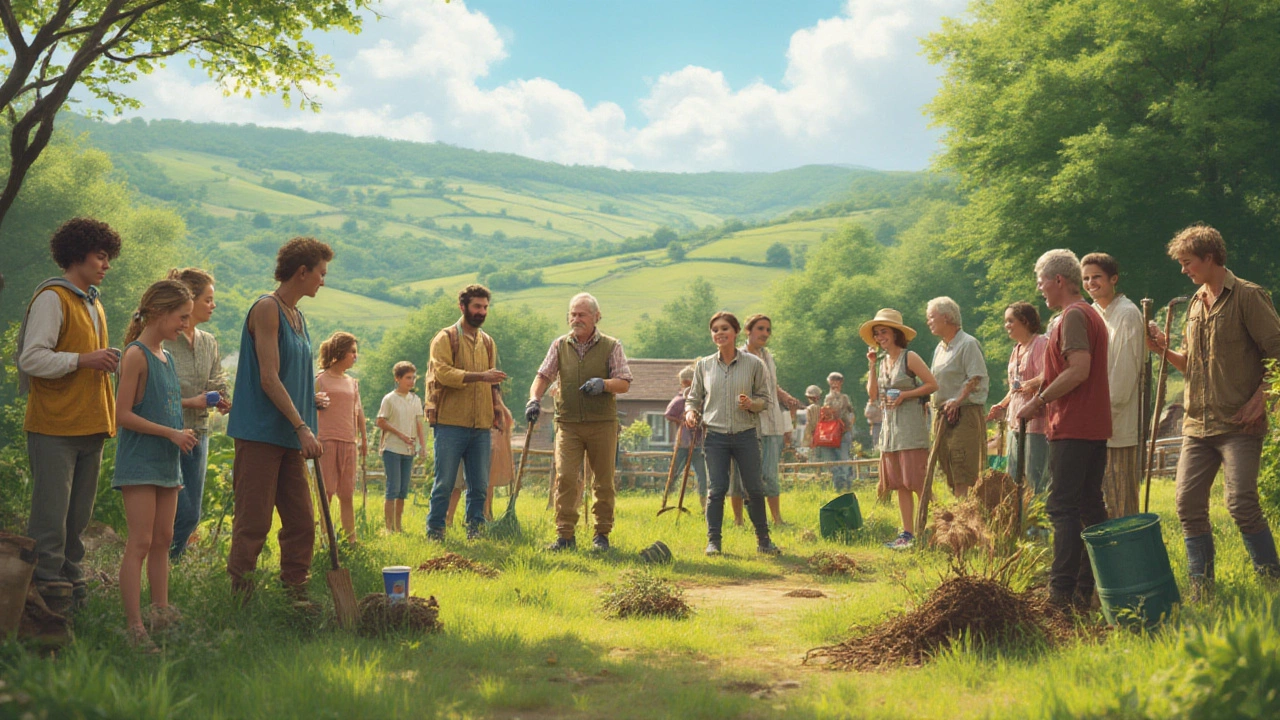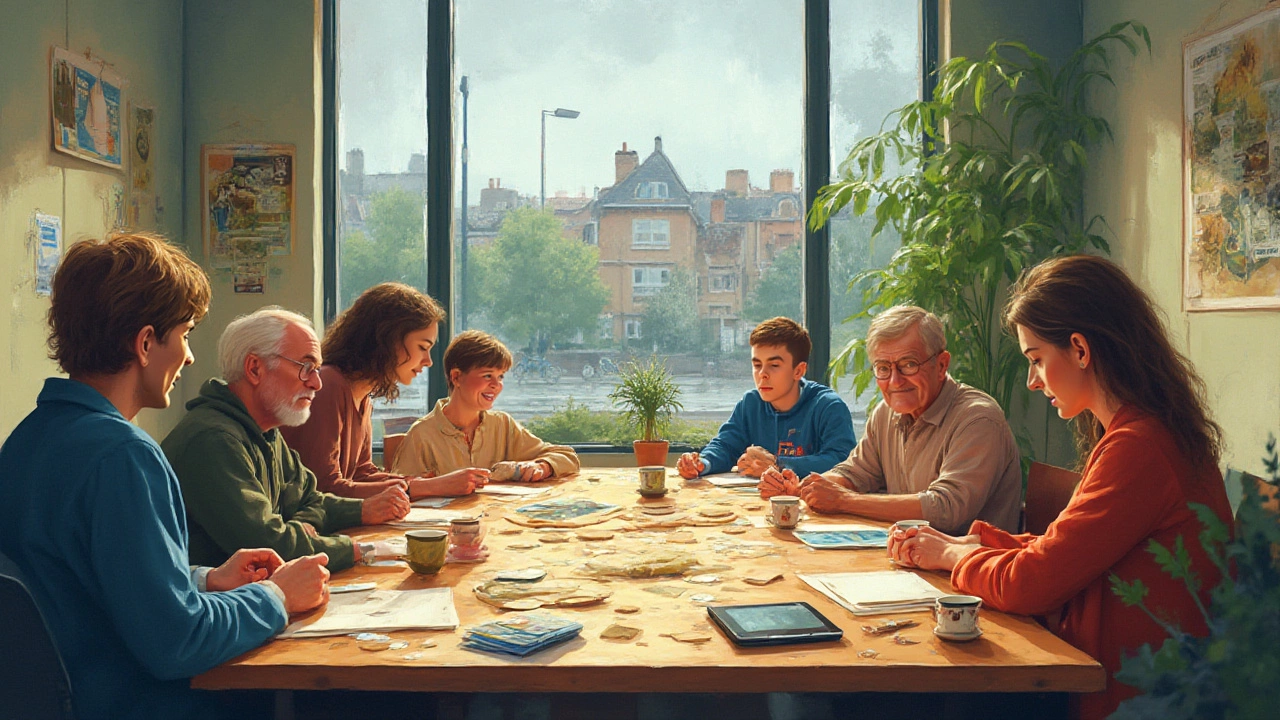Understanding Environmental Communities: What They Are and Why They Matter
 Jul, 27 2025
Jul, 27 2025
Picture this: families swapping seeds at a Saturday market, neighbors transforming empty lots into buzzing gardens, and school kids counting bees as part of their science class. It sounds almost too good to be real, but these scenes are everyday moments in active environmental communities. The idea isn't just about hugging trees or protesting pipelines. Instead, it's ordinary folks rolling up their sleeves and working together to tackle big issues—sometimes in small, practical ways. Whether they live in city apartments or country cottages, these people care about more than recycling their bottles; they're rethinking how we all live, work, and support each other in a changing world.
What Makes an Environmental Community?
At its heart, an environmental community is a group of people coming together—physically or virtually—to take care of the natural world around them. This could mean friends organizing a river clean-up, an online group swapping tips for waste-free living, or even an entire neighborhood sharing solar panels. It's more than a club or a trend; it's people finding common ground and working together to make real, practical changes. Some groups stick to local issues like improving a city's public parks, while others stretch their efforts globally, fighting plastic pollution or protecting endangered species. They can be tightly organized, like the Sierra Club, or relaxed and DIY, like a patchwork of backyard composters keeping their leafy suburbs thriving.
What really ties these groups together is a shared goal: make a positive impact on their environment. Sometimes, this goal comes with a mission statement and a well-funded board. Other times, it's just a few friends sharing ideas and lending a hand. And the best part? They welcome anyone, from lifelong environmentalists to total newcomers. According to a survey from the Environmental Protection Agency in 2023, people who participate in community-based sustainability efforts are three times more likely to stick with long-term eco-friendly habits. It's not just about organizing big protests or signing petitions. Environmental communities thrive on coffee chats, weekend gatherings, and real connections. That local flavor keeps people grounded and motivated, even as the issues can feel overwhelming.
Schools are getting in on the act, too. More than 40% of U.S. public schools now feature some form of green club or eco-team, up from just 22% a decade ago. Kids grow their own veggies, track energy use in classrooms, and even upcycle old school supplies. And they're not stopping there. Some of these student groups partner with local governments to plant street trees or monitor water quality, showing that good ideas can catch on quickly when people step up. Faith groups, sports teams, even local businesses can play a part. Shared purpose is what holds it all together, no matter the group's size or shape.
Types of Environmental Communities and How They Work
You might be surprised at just how many shapes an environmental community can take. Some are born out of crisis—say, after an oil spill or devastating wildfire. Others come together slowly, as neighbors realize shared gardens grow tastier tomatoes and tighter friendships. Classic examples include volunteer litter-pick groups, conservation organizations, and climate action collectives. But these days, there's a massive surge in online eco-communities, where advice and activism spread faster than ever before. A single viral post can launch an international tree-planting campaign or fund clean water for thousands in one afternoon.
Structure varies, too. Some communities have official membership, monthly meetings, and bank accounts; others don't even have a leader, just regulars who show up with good ideas. There's also a big divide between project-based groups, which focus on one issue (like saving a local wetland), and ongoing networks that address many kinds of environmental challenges. WhatsApp chats, Discord servers, and Facebook groups have become popular places for quick idea swaps, event planning, and resource sharing. In Tokyo, a city of 14 million, one community group manages city-wide bike repair workshops using only a free messaging app and a shared online spreadsheet. No red tape, just pure drive.
Legal status can play a role, too. Some environmental communities are set up as charities or nonprofits, letting them apply for grants, receive donations, and sometimes even hire full-time staff. Others operate completely under the radar, with zero paperwork—just people meeting up to get things done. Local regulations can shape what activities are allowed, especially for groups organizing large events, fundraising, or land restoration projects. It's also common to see environmental communities working closely with local governments, businesses, or schools. These partnerships can unlock funding, training, and official support. For example, in Denmark, over 350 local eco-groups partner directly with the Copenhagen city government to create green roofs, cycle lanes, and wetlands on former industrial land. Collaboration often unlocks results at a scale that small groups just can’t reach alone.

Why Environmental Communities Matter
The daily headlines are hard to miss: melting glaciers, wildfires, droughts, and species vanishing. Faced with problems that seem way too big for any one person, environmental communities prove that teamwork punches far above its weight. When people connect face-to-face and set manageable goals, they can turn gloom into action. A 2022 study from Rutgers University found that neighborhood clean-up programs reduced litter by up to 70% after just six months—and those involved felt more optimistic about making a difference, too. Researchers often spot what they call the “ripple effect”: one community’s success inspires others nearby to launch their own projects.
These groups move at the speed of people’s lives, balancing work, family, and daily stress. They break up overwhelming problems into local steps—restoring a pond or getting a local park to stop using pesticides. This hands-on approach builds confidence, but it also spreads knowledge that’s practical and tailored. Who better to fix a polluted stream than the families living downstream or people who’ve fished there for decades? Environmental communities create a sense of shared ownership. That’s why they’re often the first to spot illegal dumping or to run education campaigns in local languages.
It’s not all work and no play. Potlucks, storytelling nights, bike rides, seed swaps—these aren’t just fun extras, they’re glue for a community that needs to last. Shared celebrations and traditions make turning up for a tree-planting session something you look forward to, not just another job on your to-do list. Plus, these communities can boost mental health; there’s solid evidence that spending time with supportive neighbors and in nature, even if it’s just weeding with friends, lowers stress and lifts your mood. In places hit by disasters, environmental groups often double as emergency support crews—cooking together, checking on elderly neighbors, and getting everyone back on their feet. That kind of resilience is no small thing.
How to Start or Join an Environmental Community
If you’re itching to get involved but not sure where to begin, you’re far from alone. The easiest first step is simply to look locally. Check for notices at your library, community center, or online neighborhood page. Many groups welcome new folks at any time, and there’s usually no expectation that you’ll be an expert. Possibilities include planting native flowers, joining neighborhood climate groups, or helping at recycling drives. If you’re into tech, explore online communities—Reddit, Discord, Meetup, and even Nextdoor all have active, location-based groups devoted to eco-action and sustainable living.
Want to build something from scratch? Find a single issue that really tugs at you. Maybe it’s food waste, disappearing pollinators, clean water, or safe bike routes. Then, invite a few like-minded people for coffee, or post a question in a local forum. Don’t worry about numbers—lots of powerful groups start with just two or three people. Focus on a simple, achievable goal: host a park clean-up, swap houseplants, or set up a free composting workshop. If things go well, expand slowly, always keeping things flexible and fun.
Here are a few quick tips to keep in mind:
- environmental community leaders see big results by focusing on action, not just talk. Try to balance meetings and planning with hands-on projects.
- Celebrate wins: Whether you plant three trees or clear ten pounds of trash, take time to mark the achievement and thank everyone.
- Embrace diversity. People with different skills, backgrounds, and interests make for healthier, longer-lasting teams.
- Let everyone pitch in. You don’t need a PhD to pull weeds or run a bake sale for new recycling bins.
It’s also smart to learn from what’s already working. Borrow ideas from successful neighboring communities, reach out for advice, and don’t be shy about asking for help. Many established groups love pairing new volunteers with seasoned folks to pass along tips and shortcuts. Stuck for inspiration? Try following environmental podcasts, YouTube channels, or newsletters. Good ideas have a way of jumping from one community to the next.
Most importantly, stick with it through the ups and downs. Change doesn’t always happen overnight, and every group will hit a few bumps. The trust and friendships built along the way often turn out to be just as valuable as the trees planted or rivers cleaned.
